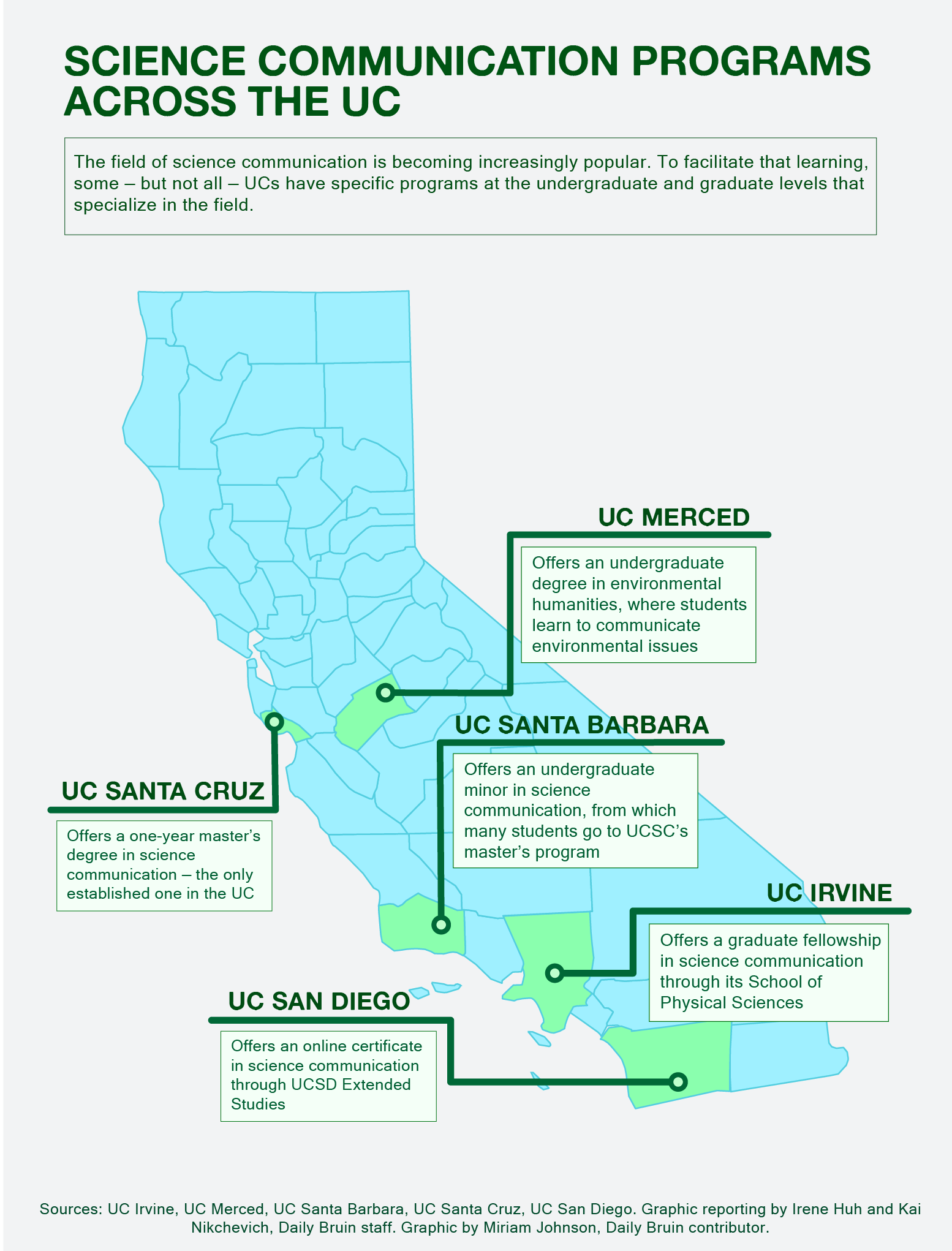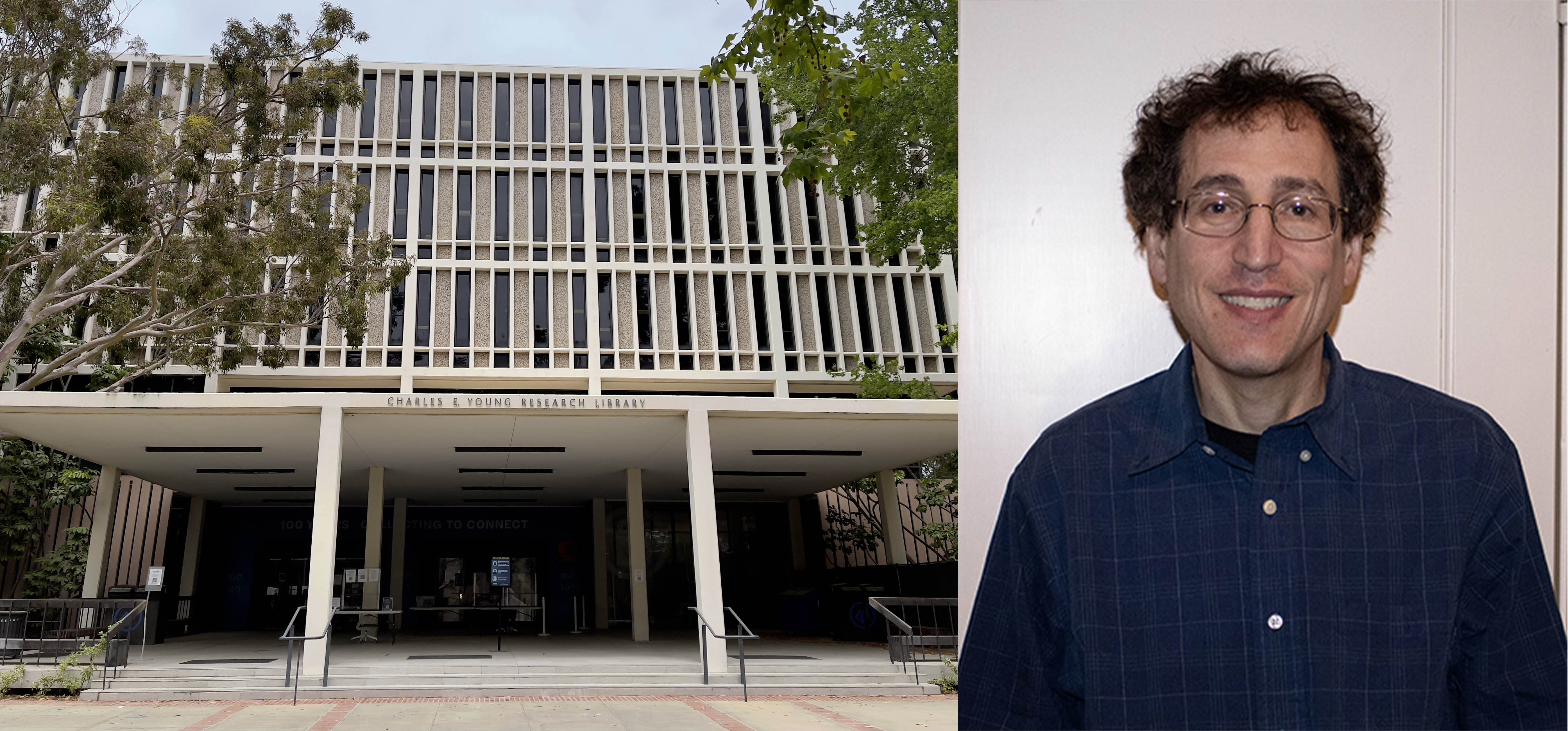‘A broader view’: How science communication is taught across the UC

A common stereotype of scientists is that they are poor at writing.
A quick internet search brings up a Reddit post that proclaims, “90% of scientific writers absolutely suck at writing.”
However, while stereotypes about scientists have long existed, science communication – which focuses on the translation of scientific information to a variety of scientific and nonscientific audiences – has gained more attention in recent years, especially following the COVID-19 pandemic.
Despite this increasing demand, many of the UC’s 10 campuses – including UCLA, where over half of students study a STEM discipline – lack formalized programs to teach students the skills needed for science communication.
UC Santa Cruz offers the UC’s only master’s degree in science communication. The program is for students who are passionate about science but are curious about a wider range of topics than they would be exposed to in a scientific research career, in which they would focus on just one aspect of a question, said program director Erika Check Hayden.
“Increasingly, we see a lot of students who feel really called to this,” Hayden said. “People feel an urgency or a calling to help drive a more positive and productive discourse about the science-related issues in society, and they feel really passionately that we need to move the needle on some of these issues.”
A November survey from the Pew Research Center found that around 27% of Americans had little to no confidence in scientists to act in the best interests of the public.
The UCSC program – which includes internships with professional publications – focuses on public-facing communication such as magazines, podcasts, videos and books, Hayden said. She added that the program focuses on communicating with people outside a discipline in the broader public.
Though there are few interactions between science communication programs within the UC, Hayden said, the UCSC program works with California State University, Monterey Bay’s science illustration program.
“It’s really beautiful,” Hayden said. “There are some things that you can explain better by seeing a graphical representation than by somebody talking to you about it.”
Other UCs have implemented science communication education at the undergraduate level. UC Merced was the first UC to establish an undergraduate degree in environmental humanities, which focuses on training communicators who can help implement environmental solutions, said Bristin Scalzo Jones, an assistant professor in the university’s Department of Literatures, Languages and Cultures.
Students are encouraged to explore the urban ecology at UC Merced through nature journaling, Jones said.
“Our main issue in environmentalism today is a communication issue,” Jones said. “I see environmental humanities as the missing link – and science communication more generally as the missing link – between having great environmental research and getting it implemented.”
Jones said she believes there can be more collaboration among UC campuses to establish degree programs in science writing and communication. For example, some of the students on the science communication track in UC Santa Barbara’s professional writing minor continue on to graduate studies at UCSC master’s program, said Amanda Stansell, who helped create the UCSB program.
Stansell, a continuing lecturer of writing at UCSB, said students in the minor participate in capstone courses, one about science in sociocultural and historical contexts and the other about writing strategies. However, because of high demand, the program is capped at 25 students per year and requires an application, she said.
Some schools, such as UC Davis and UCLA, do not have formalized programs but instead offer individual courses in science communication skills. Denneal Jamison-McClung, the associate director of UCD’s biotechnology program, teaches a graduate course where students explain scientific research to high schoolers.
Jeannie Barber-Choi, the communications coordinator for the UCLA Division of Life Sciences, said she created the Ecology and Evolutionary Biology C179 course series, which teaches students to communicate their scientific findings. The three-part series begins with a seminar, followed by a quarter of student research and culminates in students communicating their findings, for instance, through short documentary-style films, she said.
“We could create a way to have them (students) form a connection, to understand what … doing research is about,” Barber-Choi said. “I realized how much people could learn from taking a broader view of science rather than jumping right into the molecules and the mechanisms.”
The small class size allows students to collaborate rather than feel pressure to compete with one another, Barber-Choi said. She added that she wanted to take the fear out of interacting with professors.
“It’s not just about the filmmaking,” Barber-Choi said. “It really is about trying to support the students and mentor the students along the way.”
In programs offered at other UCs, such as UC Irvine School of Physical Sciences’ graduate fellowship in science communication, students have skip the education step and focus more on real-world science communication.
Some of UC Berkeley’s graduate students and postdoctoral scholars run an independent magazine, the Berkeley Science Review. Sheridon Kelly, the magazine’s editor-in-chief, said science communication allows people outside the scientific field to know what is happening.
“In academia, people get stuck in the ivory tower,” Kelly said. “We want it to be accessible to anybody who picks up the magazine.”
Many interviewees emphasized the link between science communication and the job market.
“It’s a growing field. I feel like I see more engagement around science communication and students wanting those skills as part of (the) science curriculum,” said Kirsten Schwarz, an associate professor of environmental health sciences and urban planning at UCLA. “More job advertisements and opportunities come across my inbox that are for science communication professionals. So, I could see a program evolving around science communication.”
Jones added that scientists can often only earn big grants from organizations, such as the National Science Foundation, if they can communicate the importance of their research.
Jamison-McClung said she believes students in scientific fields should also get more practice publicly speaking to general audiences, such as through partnering with local high schools or a local school district.
“The scientist in the lab coat that doesn’t talk to anybody. … That’s going to be a rare bird in science,” she said. “Most of us have to be very communicative and able to engage with other people. Otherwise, your work is not going to go anywhere.”




